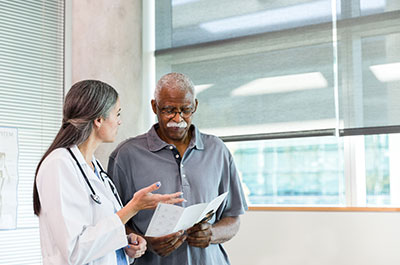Stroke is a is a multifactorial condition that can affects many of your brain’s primary processes. The side of the brain – left or right – that is affected by the stroke can also indicate what type of symptoms you might experience or what functions are impacted as a result.
“Some common symptoms like facial drooping and speech changes are possible with any type of stroke,” says Shaneela Malik, M.D., a neurologist at Henry Ford Health. “However, since the left and right sides of the brain are related to separate processes of the body, there are some differences in how these strokes present.”
Here is a breakdown of the difference in these symptoms – any why getting quick treatment for a stroke is necessarily regardless of its location.
Left Side Stroke Symptoms
The left side of the brain is responsible for our understanding of language and processing logic. When someone has a stroke that affects the left side of the brain, it is common to experience language deficits. Other symptoms may include:
- Difficulty finding your words
- A delay in processing thoughts or speech
- Confusion related to understanding conversations
- Slurring or garbled speech
In some cases, left side stroke can also impact your logic and judgement. Some people experience this by suddenly struggling to calculate numbers or make estimations.

Right Side Stroke Symptoms
The right side of your brain is responsible for spatial and visual awareness. Patients who have a stroke in this side of the brain are likely to experience balance issues or coordination changes. Other symptoms may include:
- Vision changes
- Weakness in limbs
- Confusion related to your surroundings
- Forgetting how to do everyday tasks such as getting dressed
- Sudden cognitive decline
Diagnosing And Treating Strokes
Identifying the signs of a stroke is crucial for receiving treatment quickly. Besides knowing these symptoms could be related to a possible stroke, Dr. Malik stresses that you can never being too cautious about behavioral changes in a loved one.
“Understanding subtle changes in a family member can make all the difference in their survival of a stroke,” says Dr. Malik. “Don’t ignore a loved one that is suddenly confused or not acting like themselves. Confusion if often the most common stroke symptom, but so many people dismiss this – risking a delayed diagnosis and brain damage.”
Regardless of where a stroke occurs, treatment is the same. If a stroke can be identified within the first few hours of symptoms, medical professionals can administer a medication called TNK that works to break up the blood clot causing the stroke. If further treatment is needed to remove the clot, patients may undergo a procedure called a thrombectomy.
Recovering From A Left Versus Right Side Stroke – Is There A Difference?
While strokes can occur in any part of the brain, the stroke location, its size and if a patient has any comorbidities will all influence how well someone is able to recover. Even very small strokes that occur deep in the brain can have devastating effects.
For example, strokes that occur on the right side of the brain can be harder to find than the left side – which can delay the diagnosis. However, left sided strokes are more likely to impact speech which is often the hardest thing to get back after having a stroke (though this does depend more on the part of the brain impacted by stroke, not so much the side).
Additionally, doctors still are learning to understand the cognitive impact that stroke has on patients. Cognition is specific to individuals, so while someone may recover physically from stroke, there are little things related to their cognitive function that doctors are unfortunately unable to measure. However, continued therapy and rehabilitation may help regain some cognitive functions.
“The best thing you can do to avoid many of the lasting effects of stroke is to seek treatment immediately,” says Dr. Malik. “Then, getting into therapy can help patients improve their physical and cognitive function over time.”
Reviewed by Dr. Shaneela Malik, a neurologist who sees patients at Henry Ford Medical Centers – Bloomfield Township and Lakeside.



